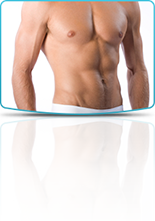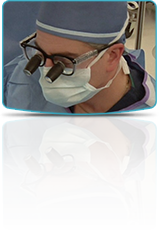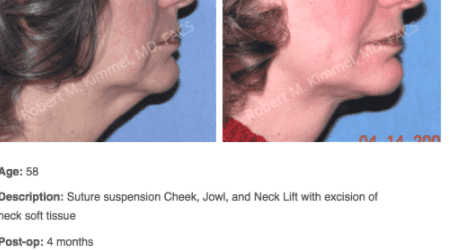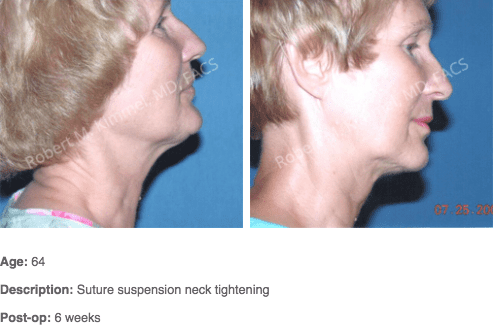Thread Lift
What is a thread lift?
A thread lift is a simple procedure where Dr. Robert Kimmel uses temporary sutures to produce a subtle, but visible lifting of the facial skin. Unlike a surgical facelift, where excess sagging skin is trimmed and underlying support tissues brought back to a higher position on the face, a thread lift uses sutures to simply suspend the skin by stitching up portions of it. This has the effect of pulling the skin back slightly and lifting and tightening the face.
These procedures have a secondary tightening mechanism. The threads used are made of the same material as absorbable surgical sutures. Once these are placed for their initial tightening, the body begins the process of absorbing the sutures, a process known as hydrolysis. This stimulates the body to produce new collagen around the threads. As the threads are absorbed, eventually turning to water, the new collagen remains, firming the skin for from six months to two years.
How does a thread lift differ from a surgical facelift?
Dr. Kimmel is a board-certified plastic surgeon, and he performs both surgical facelifts and thread lifts for our patients from all over Pennsylvania. While both procedures lift and tighten sagging facial skin, they do so in very different manners.
A surgical facelift removes the underlying connections of the facial skin. The skin is then lifted back to its former higher position and the underlying muscles and support tissues are anchored in their higher positions. Any excess skin is then surgically trimmed. These procedures create incisions that need to be hidden in the hairline or the crease in front of the ears, and they have lengthy recovery times due to the repositioned skin. Facelifts provide permanent tissue elevation and long-lasting results.
In a thread lift, only local anesthesia is necessary, and the procedures take just 45 minutes. Dr. Kimmel inserts the threads with a tiny cannula or needle into the different layers of the skin. The threads have barbs or cones that help them hold the skin. By positioning the threads to elevate the skin, this creates lifting and rejuvenation. The body begins the process of absorbing the threads, which is an inflammatory response where new collagen is created. With a thread lift there are no incisions, and very little, if any, recovery. As you would expect, results from thread lifts do not last as long as a surgical facelift.
Thread Lift Before & After Photos
What issues can a thread lift address?
Thread lifts provide the same kinds of improvements that surgical facelifts do, only on a smaller scale. Dr. Kimmel doesn’t want patients to think this replaces the need for all facelifts. It doesn’t. But thread lifts are good procedures for more limited results in these areas of the face:
- Cheeks
- Brows
- Undereye areas
- Crow’s feet
- Nasolabial folds
- Naso jugal folds
- Wrinkles around the mouth
- Jaw line
- Jowls
- Neck
Who is a good candidate to have a thread lift?
The best candidates for a thread lift with Dr. Kimmel are in the early stages of facial and jowl laxity. Although the results are not as dramatic as a surgical facelift, they provide subtle rejuvenation in the cheek, jowls, and neck. The procedure is especially good for those who’ve had a previous facelift but are starting to see some sagging again due to aging. For patients with more extensive skin sagging, a thread lift is probably not the best option. A surgical facelift can better address more significant sagging. Since Dr. Kimmel also performs surgical facelifts, during your consultation he can discuss with you if he believes that could be a better solution due to your more extensive skin laxity.
Is there anything I need to do to prepare for a thread lift?
There isn’t any preparation necessary. Only topical anesthesia is used, so there isn’t any need to restrict food prior to your thread lift. Recovery is not involved, so you don’t really need to prepare an area for recovery time, as you would for a surgical facelift.
How does Dr. Kimmel perform a thread lift?
A thread lift is minimally invasive. After applying a local topical numbing agent, Dr. Kimmel inserts the threads by tiny cannulas into different layers of the skin. The threads are made from polydioxanone, the same material used in dissolvable sutures. There are different types of threads — they are divided into floating, non-barbed, and barbed — to be used depending on the degree of suspension needed in the area. Once inserted, the threads anchor the skin and lift it upwards, eliminating sagging.
How long does a thread lift take to perform?
These procedures only take about 45 minutes.
Is there recovery after a thread lift?
Some bruising and swelling are common after the insertion of the threads, but this should resolve itself in 3-7 days. As mentioned above, to allow the threads to intertwine with your tissue effectively, it’s best to avoid strenuous exercise or exertion for a week.
What kind of results can I expect with a thread lift? How long will they last?
The threads provide immediate lifting as they lodge in the skin and lift sagging areas. That’s the first step. For the first week, the treated areas will look a little tighter than they will end up, but they will settle into a natural look.
From there, the threads initiate the body to form collagen and fibrous connective tissue around the threads. This tightens, firms, and volumizes the treatment areas. In about nine months, the threads will have completely dissolved. If a second thread lift is performed at this time, the results can last up to three years.
Is there anything I should do after my thread lift?
Most patients can return to normal activities or work the next day after their procedure with Dr. Kimmel. It’s important to allow the threads to settle down and intertwine with your tissues. This creates the best tissue suspension. To make it easier for your skin to do this you need to avoid strenuous exercise or exertion for at least one week after your threads are placed.
Is a thread lift painful?
Topical anesthetic is used at the sites where Dr. Kimmel will insert the threads, so there isn’t any pain. Sedation is also available if the patient wants to relax fully.
Are thread lifts safe?
The threads used for thread lifts has been used in surgery for decades. These are absorbable sutures. Allergic reactions are exceedingly rare, and the material has been very successful.
Still, there is potential for some side effects. Bruising, swelling, tenderness, and slight asymmetry are possible. Sometimes the threads can be visible on the skin surface. Temporary skin dimpling can occur. These problems usually resolve over the following weeks. Remember that the body eventually absorbs the threads.











 THE OFFICE
THE OFFICE